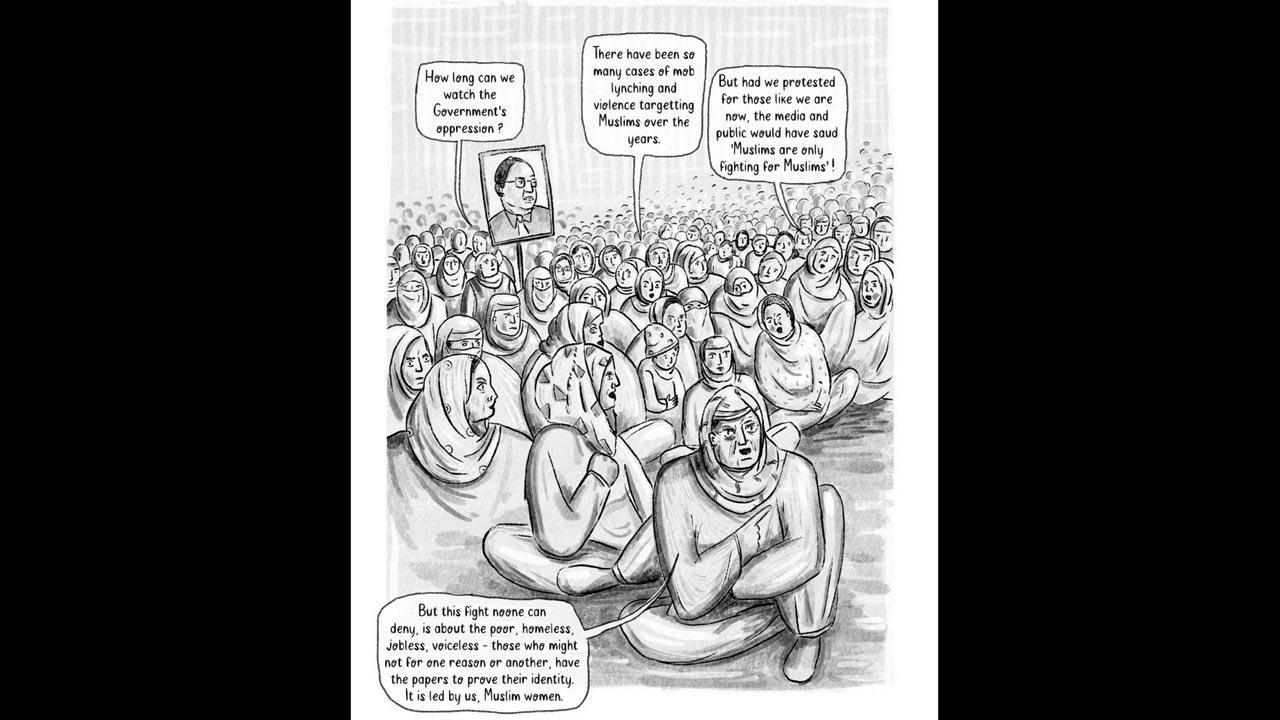A graphic narrative unveils how the sit-in protest — initiated by women of the Delhi neighbourhood against CAA-NRC — gave birth to a larger movement

Panels from the book. Pics/Ita Mehrotra, Yoda Press
In December 2019, when the rest of Delhi was busy warming up for the biting-cold winter ahead, small groups of Muslim women residing in Shaheen Bagh started banding together during the foggy nights. Often accompanied by their kids and husbands, they’d sit near the highway, chanting slogans, singing songs, and discussing the way ahead for their ilk, which faced the threat of being wiped out by the National Register of Citizens (NRC) and Citizenship (Amendment) Act (CAA) that were being imposed by the Centre. The freezing winter, the ruthless criticism, a heartless administration, the gunned threats and even a burning riot — nothing deterred them. How could it? Their children had been attacked, and their very identity was at stake.
ADVERTISEMENT
What started out as a sit-in to mark dissent against the government, snowballed into a people’s movement over the next three months, its ripples felt across the country, including at our very own Mumbai Bagh. Visual artist and researcher Ita Mehrotra, who watched it all unfold in front of her eyes, has documented this awe-inspiring journey in her upcoming title, Shaheen Bagh - A Graphic Recollection (Yoda Press). The Delhi-based artist, who has in the past sketched the battles of the Chipko movement leaders and Irom Sharmila, shares, “I see the role of an artist as being essentially political, in taking stands against an increasingly oppressive state, and expressing those creatively.”
In the graphic narrative, the 31-year-old has fleshed out the burqa-clad women, their palpable fears and anxieties, and their unfailing determination to brave the dark night. The monochromatic panels pack in interviews with women who were at the core of the sit-in as well as attendees, media reports and Mehrotra’s ground-level view of the happenings. She recollects that in the early days of the sit-in, when she was sketching and making posters at the site, she realised the need to recognise the protest as something bigger. By February 2020, as she began having longer conversations with people at the protest from Shaheen Bagh, it became clear that telling the stories needed more time, which is when the publisher approached her for the book. “When the anti-CAA protests began, one evening, I along with a group went to Shaheen Bagh. A small group of about 50 women and children had gathered on makeshift carpets; there was no press. But the spirit of this being a women-led protest space, with Muslim women from Shaheen Bagh and neighbouring areas coming out of their homes, was very powerful,” she reminisces.
In the book, too, while Mehrotra’s strokes trace the history of Shaheen Bagh, the violence at Jamia, the participation of students and citizens in large numbers, the Delhi riots and the media attention, it’s the Muslim women who remain in focus. They are what set Shaheen Bagh apart, she notes: “As the movement grew, with Muslim women remaining at the centre, the call to collective action without lifting up one leader, was very strong. It opened up the possibility to have safe public spaces with women out all night.”
Ita Mehrotra
At a time when physical protests look difficult — thanks to COVID-19 and shrinking space for free speech — the book serves as a reminder to voice dissent. “Political comics and illustrations that combine opinions and stories through image and word have a powerful language. There are ongoing protests like the one by farmers; in this context, the ability to form solidarities between movements, through how histories are told, is a narrative that books can shape,” she signs off.
Log on to https://t.co/kIbBosmv2T
Cost Rs 550
 Subscribe today by clicking the link and stay updated with the latest news!" Click here!
Subscribe today by clicking the link and stay updated with the latest news!" Click here!






